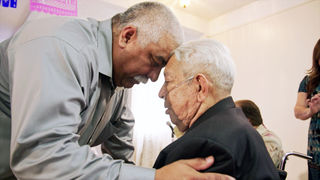Environment
Alternate Endings: Six New Ways to Die in America
An HBO documentary by Matthew O’Neill and Perri Peltz
Posted August 12, 2019 Reviewed by Lybi Ma

When my parents died, separately, over a period of time, my sister and I learned that they had arranged everything for their funeral and burials. We could not have been more grateful at a time when grief and loss prevailed. We were spared needing to deal with any ambiguity about their wishes as well as the obsessional, detailed planning that erupts in the wake of death: cremation or burial; casket or urn, and the abundance of choices among each of them; what to do about the remains; the rituals; the cemetery (or not); the wake or shiva; the headstone, to name a few.
None of us escapes the loss of a loved one. Which makes Alternate Endings, Six New Ways to Die in America universal in its relevance and meaning to all of us. We will all face and need to live through such a fundamental, human experience. We are all, thus, emotionally vulnerable to those in the funeral business who can capitalize on our losses. Their revenues exceed $16 billion a year.
Mr. O’Neill and Ms. Peltz, in this 67-minute HBO documentary, courageously and intimately take us into the lives of six families. Families who, with their dying loved one (adult or child), decide to take control – ahead of time – and customize, if you will, the preparations for what will ensue after the last expiratory breath.
These accomplished documentarians take us to sea floors to see the beauty of underwater tombstones designed to help restore reefs and other ocean life. I grant you not an easy place to visit, but neither is a cemetery. We learn how all of us can create Living Wills, where a person ill and facing death can, with their cognitive functioning alive and well, specify how they want things to go. I have a living will which details my organ donations, cremation, and the already purchased crypt storage of my remains above the ground in Manhattan.
There are “green burials” mindful of the peril we already have created for our environment and climate. Why have your ending make things worse for your family and friends, and their progeny? A green burial is in a shallow grave to allow for our body to more rapidly decompose and thereby add our organic matter to enrich the soil. The symbolism here is wonderful: we are not dying – we are becoming part of the enduring life of our planet.
And what about outer space? Imagine being launched by a rocket for burial in space. No longer a fantasy in fictional films where things go wrong and an astronaut is lost in space. We join a group of 45 families as they make an awesome ‘blast(off)’ of the end of life on earth, in more ways than one.
The filmmakers bring us deep into the particularly controversial topic of “medical aid in dying”. While a person facing death is still mentally competent they can elect to “die with dignity”, to abbreviate their suffering (and that of others keeping vigil). They obtain, by medical prescription (not the dark web), the medications that will deliver them to a peaceful death, sometimes called a ‘drug cocktail’ to bring on the inevitable.
To not implicate anyone else in such a means of dying, the person must self-administer the fatal drug cocktail, surrounded and supported by loved ones, who hold the dying person’s hand and lend comfort to him or her, and each other. Warning, you will witness a moment, quiet and solemn, of a man passing by his own determination to bring to a close this chapter in his life.
The film’s arc ends with the death of a child. A 5-year-old boy, Garrett, who with the wisdom of a babe said: “I don’t want a funeral.” He wanted, and his parents respected, instead, a ceremony that would honor his wishes to not become part of the way things were, with funerals, but instead the way they could be. Any story about a lovely, dying child is very hard to bear. But kids die too, less so today; not all live to become adults. O‘Neill and Peltz do not let us close our eyes to the morbidity, mortality, and fatality some children and their families endure. This boy and his parents want to experience death with dignity, and to celebrate his time on earth, however ephemeral.
Alternate Endings is not a doom and gloom film. Instead, it is a film more about life than death. It is about taking death head-on and arriving at it on your own terms and by means that can meet each person’s values and needs. It is a film about choice, dignity and human connectedness and community. And it is, as well, surely about the conviction so many of us hold that death is but one moment in the endless, continuity of life. Which means never dying but always being reborn. That’s what makes for the undercurrent of joy running throughout this brave documentary about dying in America.


